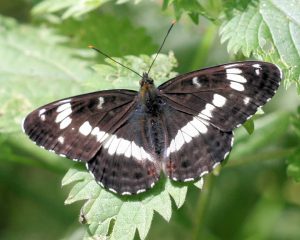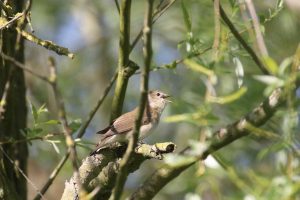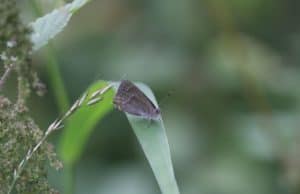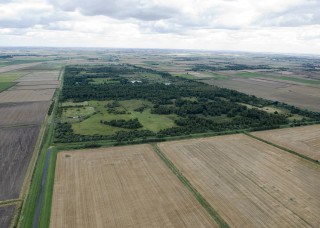Woodwalton Fen (the Great Fen Project)
Led by Henry Stanier, BCNWT Monitoring and Research Officer.
RNHS Visit to Woodwalton Fen Sunday 8th July 2018
The weather has been hot and dry for several weeks, and perhaps was too hot for many of our members to venture south to Woodwalton Fen.
Nevertheless a select group met with Henry Stanier, BCN Wildlife Trusts’ Monitoring and Research Officer at 10.00 am on the new bridge at the entrance to the reserve, watching fish below and damselflies floating around above them.
The reserve is an historic site, the second of the nature reserves set up by the Rothschilds, the first being Wicken Fen, and given to the predecessor of the Wildlife Trusts in 1919. The area is being redeveloped as a nature reserve, and purchase of surrounding land will eventually result in a link to Holme Fen to make a much larger area for the benefit of wildlife.

Our first dragonfly was a Brown Hawker, zooming overhead, followed by a White Admiral butterfly circling the oak trees as we strolled along the pathway between tall reeds alongside a waterfilled dyke. Azure damselflies and a Large Skipper flitted between the reeds alongside the path, and a Four-spot chaser rested on a frond, wings shining in the sun. Sharp-eyed members spotted a Short-winged Conehead on a blade of grass, which obligingly stayed to be photographed. Male and female Ruddy Darters were spotted and a Garden Warbler sang his melodious bubbling song.

A freshly emerged lemon-yellow Brimstone butterfly looked conspicuous, but disappeared as soon as it settled onto the leaves of a willow tree, becoming an indistinguishable part of the foliage. We found a quiet haven from the sun in a shady area by the Rothschild’s summer house, a lovely thatched cottage built on piles in the fen. We were able to see how much the peat has shrunk in the years since the cottage was built, at least 3 or 4 feet, and marked on one of the pillars were the flood levels for various years.

Purple Hairstreak butterflies flitted above the treetops, occasionally stopping long enough to be caught in binoculars, while a Red Admiral and Peacock flew around the thatch. Crossing a small dyke a female Southern Hawker patrolled and damselflies mated in the ‘heart’ formation. We saw Frogbit, a floating leaved plant, with three-petalled white flowers, the leaves used as resting places for damselflies, and also yellow-flowered Bladderwort, and later we observed the bladders in the fernlike fronds below the clear water. A cricket was spotted after Henry found the call using the bat detector, and was identified clearly as a Roesel’s Bush Cricket. Pale pink Hemp Agrimony flowered beside the path, as tall as the reeds, and Marsh Sowthistle towered above our heads. The time had passed all too quickly, and we returned to the bridge, where we were treated to the sight of a blue Emperor Dragonfly patrolling the drain. A Scarce Chaser perched on a reed, identified by his blue eyes, showing a dark area between wings and tail where females had held on to him during mating, the blue colouration worn away. We were not finished yet – Red eyed Damselflies sat on water-lily leaves, and a Black-tailed Skimmer whizzed past. The fish, Perch and Rudd, were still busy just beneath the surface. Finally we said our goodbyes and left the peaceful reserve for home.
On investigating photographs later a member spotted yet another species – a large spider – possibly a Fen Raft Spider, skulking beneath one of the leaves on a picture of damselflies mating on a lily pad.
Thanks to Henry Stanier for leading us with his knowledge and observation skills on an amazing morning, making us wonder why we didn’t come sooner!
